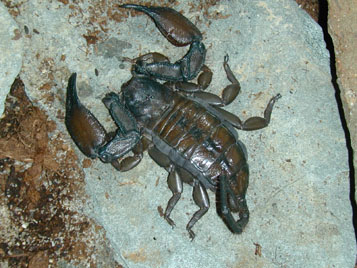Hadogenes troglodytes |
||
 |
||
Common names:
Often known as South African Rock Scorpion or
The Flat Rock Scorpion.
Distribution:
Africa (Botswana, Mozambique, South Africa, Zimbabwe).
Habitat:
H. troglodytes is a variable species but they
all essentially occur in drier, bushveld areas that
recieve less than about 600mm mean annual rainfall. They
are restricted to areas with a type of rock that will
split to form cracks for them to live in. This includes
sandstone and granite. They seem to prefer living at the
bottoms of hills rather than higher up. Adults usually
occupy cracks about 1.5cm in width, with juveniles
occupying smaller cracks so as to decrease competition
with adults. They can be quite dense in some areas,
getting to the point where almost every available crack
will have a scorpion in it.
Venom:
This species has a mild venom. It will rarely
sting, and usually defends it self by using the powerful
claws. LD50 values are reported between 1800-2667 mg/kg.
Claws are used for defense, and can be very painful to be
caught by.
Selected litterature:
Bullington, S.W. (1996). Natural history and captive care
of the flat rock scorpion Hadogenes troglodytes
. Vivarium 7(5), pp.18-21.
Newlands, G., and A.C. Cantrell. (1985). A re-appraisal
of the rock scorpions (Scorpionidae: Hadogenes). Koedoe
28, pp. 35-45.
Williams, S.C. (1971). Birth behavior in the South
African scorpion
Hadogenes. Pan-Pacific Entomol., 47,
pp.79–80.
On the Internet:
Natural
History and Captive Care of the Flat Rock Scorpion, Hadogenes
troglodytes (Peters) by Stephen W. Bullington.
Flat Rock Scorpion (Hadogenes troglodytes)
by Joe Fouskaris.
French website with information on H.
troglodytes.
Differentiating South African Flat-Rock
Scorpions
General:
Alle Hadogenes have very elongated, flattened bodies and
powerful pedipalps. The body shape together with a stout,
spinelike setae (which poerate in conjunction with highly
curved claws) are adaptions to life in cracks and
crevices (the latter caracteristics provides the legs
with a strong grip on the rough surface of the rocks).
Males have a very long and thin cauda, and some have been
reported to reach over 21 cm in bodylenght. Females have
a body lenght between 15-20 cm, and can gain a weight
between 30-40 g.
This species is kept in captivity, and is a very popular species because it is very large, long-lived and quite hardy. Captive breeding has been reported, but I'm missing data on the survival rates of the scorplings.
Some scorpions sold in the pet trade as H. bicolor is probably H. troglodytes, which is found in several color forms (Dr. Lorenzo Prendini, pers. comm.). This page shows a dark colourform, while the more typical brighter colorform can be seen here. H. bicolor is quite rare, and is probably not found in the pet trade at all.
H. troglodytes catch many different prey types as most scorpion, but is quite special because they are reported to prey on terresttial molluscs.
Hadogenes troglodytes (dark
colorform) photo by Jan Ove Rein (C).
Part of the information in this species
file is supplied by Ian Engelbrecht